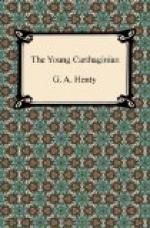Near them are a party of men lighter in hue, taller and stouter in stature. Their garb is more irregular, their arms are bare, but they wear a sort of shirt, open at the neck and reaching to the knees, and confined at the waist by a leather strap, from which hangs a pouch of the same material. Their shirts, which are of roughly made flannel, are dyed a colour which was originally a deep purple, but which has faded, under the heat of the sun, to lilac. They are a company of Iberian slingers, enlisted among the tribes conquered in Spain by the Carthaginians. By them lie the heavy swords which they use in close quarters.
The third body of men are more heavily armed. On the ground near the sleepers lie helmets and massive shields. They have tightly fitting jerkins of well-tanned leather, their arms are spears and battleaxes. They are the heavy infantry of Carthage. Very various is their nationality; fair skinned Greeks lie side by side with swarthy negroes from Nubia. Sardinia, the islands of the Aegean, Crete and Egypt, Libya and Phoenicia are all represented there.
They are recruited alike from the lower orders of the great city and from the tribes and people who own her sway.
Near the large grove in which the troops are encamped is a smaller one. A space in the centre has been cleared of trees, and in this a large tent has been erected. Around this numerous slaves are moving to and fro.
A Roman cook, captured in a sea fight in which his master, a wealthy tribune, was killed, is watching three Greeks, who are under his superintendence, preparing a repast. Some Libyan grooms are rubbing down the coats of four horses of the purest breed of the desert, while two Nubians are feeding, with large flat cakes, three elephants, who, chained by the leg to trees, stand rocking themselves from side to side.
The exterior of the tent is made of coarse white canvas; this is thickly lined by fold after fold of a thin material, dyed a dark blue, to keep out the heat of the sun, while the interior is hung with silk, purple and white. The curtains at each end are looped back with gold cord to allow a free passage of the air.
A carpet from the looms of Syria covers the ground, and on it are spread four couches, on which, in a position half sitting half reclining, repose the principal personages of the party. The elder of these is a man some fifty years of age, of commanding figure, and features which express energy and resolution. His body is bare to the waist, save for a light short sleeved tunic of the finest muslin embroidered round the neck and sleeves with gold.




